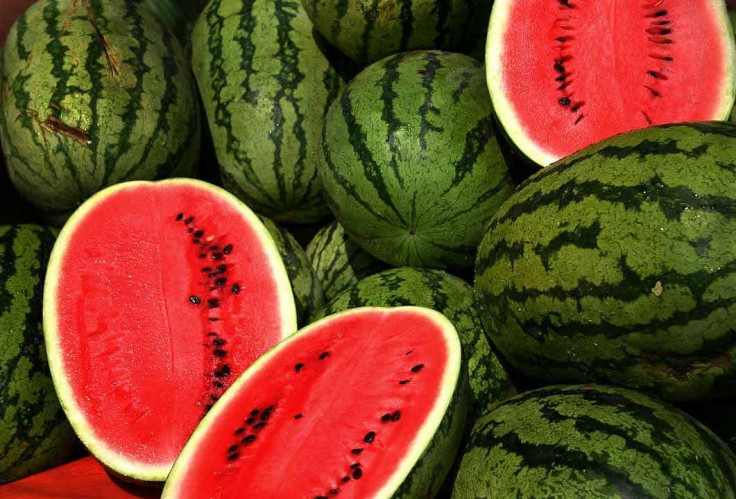Watermelon Nutrition: Good Health In A Sweet Package

Who doesn't love watermelon?
By weight, watermelon is the most-consumed melon in the U.S., followed by cantaloupe and honeydew, and its popularity appears to be on the rise. The U.S. Department of Agriculture reports that per capita consumption has increased from 13.8 lbs. in 2000 to 15.1 lbs. in 2011, which represents a 9.4 percent increase. A perfect hot weather treat and welcome addition to many recipes, watermelon is 92 percent pure H2O as its name suggests. Yet, contrary to popular belief, it is not a fruit, but a vegetable. First-cousin to squash, cucumbers, pumpkins, and cantaloupes, the watermelon is a member of the gourd family and, as such, provides immense nutritional value.
Health Benefits
Because water makes up the bulk of its flesh, watermelon is relatively low in calories. Unfortunately, a large portion of the calories in this food come from sugars. Fructose, which is a natural fruit sugar, makes up the majority of the sugar content of watermelon. On the plus side, watermelon is very low in saturated fat, cholesterol, and sodium.
A good source of potassium, watermelons provide vitamins A and C as well. Potassium helps to regulate blood pressure and may help to prevent hypertension, a risk factor for heart disease. Vitamins A and C help maintain proper vision as well as general health. In addition, watermelon contains a modest amount of dietary fiber, which is indigestible matter that promotes the movement of stool through your digestive system.
Lycopene, which acts as an antioxidant in your body, contributes to the reddish-pink hue of this melon's flesh. Watermelon provides one of the richest dietary sources of lycopene. Numerous studies correlate high intake of lycopene-containing foods or high lycopene serum levels with reduced incidence of cancer, cardiovascular disease, and macular degeneration, according to Mayo Foundation for Medical Education and Research.
History
Watermelon is thought to have originated in the southern African countries and then spread to all tropical and subtropical regions. Yet, historians believe that in the 16th century, Native Americans had begun to grow watermelons. French explorers discovered the fruit in the Mississippi Valley. Food historians and horticulturalists believe African slaves and European colonists introduced and distributed watermelons to many areas of the world. Certainly, the first cookbook in the U.S., American Cookery, by Amelia Simmons, published in 1796, contains a recipe for watermelon rind pickles. During the Civil War, the Confederate Army boiled down watermelons as a source of sugar and molasses.
Today, there are many varieties of both seeded and seedless watermelons grown commercially in the U.S., with the majority of crops in Florida, Texas, California and Arizona. For those who worry about genetically modified foods, seedless watermelons are not GMO. They are hybrid watermelons that have been grown in the U.S. for more than 50 years and are safe and delicious in every way.
It takes around five weeks for a tiny watermelon flower to grow into a ready-to-eat watermelon. Although ripe watermelons typically weigh anywhere from 5 to 40 lbs., record-breakers have tipped the scales at 250 lbs. or more. Increasingly, farmers focus on growing "personal-sized" melons without seeds. Most of us, though, are content with whatever watermelons are available and hope to choose one that tastes sweet.
How Do I Pick A Good One?
Supermarkets abound with watermelons during the summer months, and shoppers passing through the produce aisle find it difficult to resist them. Yet many people also feel unsure when choosing a watermelon. No need to be intimidated. Simply follow these four steps:
- Look the watermelon over.
You are looking for a firm, symmetrical watermelon that is free from bruises, cuts, dents, or bumps. Dull is better than shiny. - Lift it up.
The watermelon should be heavy for its size. Compare its weight with one of a similar size. - Turn it over.
The underside of the watermelon should have a creamy patch, referred to as the field spot, where the watermelon rested on the ground. The deeper the color, the longer the fully grown melon was on the vine getting sweet. Yellow is better than white, but white is better than no patch at all. - Thump it.
Hold the melon away from your body and give it a few good raps with your knuckles. Listen for a "full" sound, higher in pitch. A deeper sound can mean it is not ripe or that the center of the fruit is separated into chunks, a condition referred to as "hollow heart." At all costs, avoid the hollow heart.



























